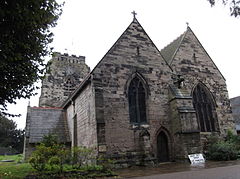Powerflush nearby to Polesworth
 Polesworth is a large village and civil parish in Warwickshire, England’s North Warwickshire district. Polesworth is located near the northern tip of Warwickshire, near the border with Staffordshire. It is only 3 miles (5 kilometres) east of Tamworth and 4.5 miles (7 kilometres) north-west of Atherstone. The village is 5.5 miles (9 km) north of the Derbyshire border, and the River Anker runs through it.
Polesworth is a large village and civil parish in Warwickshire, England’s North Warwickshire district. Polesworth is located near the northern tip of Warwickshire, near the border with Staffordshire. It is only 3 miles (5 kilometres) east of Tamworth and 4.5 miles (7 kilometres) north-west of Atherstone. The village is 5.5 miles (9 km) north of the Derbyshire border, and the River Anker runs through it.
In the 2011 census, the civil parish of Polesworth had a population of 8,423, which included the contiguous sub-villages (often regarded as suburbs) of St Helena, Hall End, and Birchmoor to the south and west.
Polesworth’s built-up area, which includes the adjacent village of Dordon to the south (a separate parish), had a population of 9,645 in 2011.
Visit this link for cleaning out rust in these postcode areas:
HISTORY
In the Old English language, the name Polesworth is derived from “pol,” which means “pool,” and “worth,” which means “a dwelling” or enclosure.
Polesworth used to be the location of an abbey. King Egbert established Polesworth Abbey in 827, with his daughter Editha (later Saint Editha) as Abbess. It flourished for 700 years before being disbanded as part of the Monasteries Dissolution. The Crown granted the Abbey’s lands to Francis Goodere in 1544, and he used the Abbey’s stones to build Polesworth Hall, a manor house.
Henry Goodere, Francis’s son, was an arts patron, and Polesworth Hall was a cultural centre during Elizabethan times. Around 1580, the poet Michael Drayton worked for the Goodere family, and his works contain references to Polesworth and the River Anker. Other notable figures included the dramatist Ben Jonson, architect Inigo Jones, and poet John Donne, who formed the core of the Polesworth Circle. It is also said that William Shakespeare stayed at Polesworth. Polesworth Hall is no longer standing, having been demolished around 1870 and replaced by the vicarage.
Pooley Hall was built around 1509 by Thomas Cockayne and contains some of the country’s oldest brickwork.
The hall still exists and has a view of Pooley View. Pooley Farm was once the home of the late American Soul and Motown singer Edwin Starr, best known for the song War.
During the English Civil War, Polesworth and Wilnecote were among the towns that owed money to the Parliamentary garrison at Tamworth. Polesworth (rated at £8 a week) was assessed and paid £196.16.0 in an account drawn up by Captain Thomas Layfield for the period from 1 November 1645 to 1 May 1646, while Wilnecote (rated at £2 a week) was assessed and paid £50.7.0. (SP 28/136/31) Formalized paraphrase
When the Coventry Canal was built through Polesworth in the 1770s, the village grew rapidly and developed a coal-mining and clay industry.
During WWII, opencast coal mining devastated the surrounding countryside, causing the Anker River to be diverted. Mining in the area has since ceased. Pooley Country Park encompasses 62.5 hectares of the former Pooley Hall Colliery site, which closed in 1965. Polesworth is now mostly used as a commuter town for nearby towns and cities like Tamworth, Atherstone, Lichfield, Sutton Coldfield, Nuneaton, Birmingham, and Coventry.

